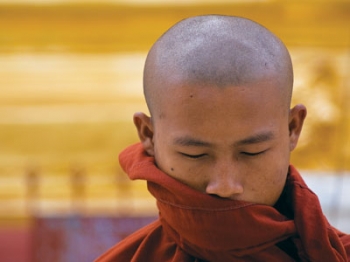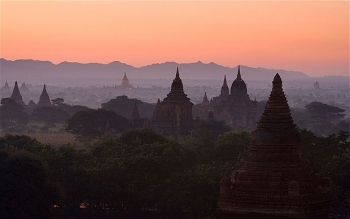In this second part of his article, Dr. Bill Mak continues his reflections about his meditation retreat in Myanmar.
On the sixth day of the practice, I was assaulted by an onslaught of wild thoughts and became greatly agitated. Despite my ability to sit in the lotus position for two hours, within half an hour of sitting down my eyes would open on their own and my mind would go wild. The meditation master said to me, “Don’t cross your legs. Don’t open your eyes. If you can’t go on with the sitting, get up slowly, do walking meditation for half an hour. Attend to mindfulness with mindfulness. Observe the mind by observing the mind.” Frankly speaking, however, wandering thoughts are not so interesting after all. Are they not just wandering thoughts? What is there to observe? Observing them would not make them disappear, but rather, fuel them to go more and more rampant. One day, I saw a cat while doing walking meditation. A thought arose: this cat looks like a chicken. This strange thought then got stuck in my mind for the entire evening.
On the eighth day, the meditation master suggested that in order to pacify my monkey mind I could also practice some “concentration” (samatha), i.e. contemplative techniques such as the “Contemplation on Buddha” (buddhanussati), “Meditation on Compassion” (mettabhavana), “Meditation on Impurities”(asubhabhavana) and the “Contemplation on Death”(marananussati). It seemed to help a bit, but since my hyperactive mind was quite beyond control at that time, nothing seemed to work. At this moment, the Venerable whom I met on the first day told me that he would take me to the forest retreat center on the next day!
The forest retreat center was exactly as I imagined: beautiful and paradisiacal. Breathing the fragrance of nature under the blue sky, I sensed harmony with the surrounding. I meditated there for three hours and developed an incredibly good feeling. Instead of wandering thoughts arising, an indescribable sense of joy arose in me. However, soon it was time for me to be ruthlessly taken back to the city retreat center.
I kept thinking about the lovely forest retreat center after returning to the urban one. Oh, forest! Oh, forest! There was no more joy. I was back in the evil world of Five Turbidities. At that time I realized this: was that not also a wandering thought revealing my attachment to the external conditions? I returned to my practice on the primary and secondary objects, and gradually found that the sense of joy had returned! I sensed an electric sensation arising throughout my body. It was very curious. Such new experience moved the entire practice of “insight meditation” (Vipassan?) to an entirely new arena, and I perceived things that I had not seen before in my sitting and walking meditations.
In the daily interview next morning, I described my experience to the meditation master. The teacher ignored me. I felt really discouraged. So I began to recite my lines again when it was time to describe my experiences on sitting and walking meditation. Suddenly the meditation master asked me a few questions, to which I offered my observations without much thought. He suddenly clapped his hands loudly and laughed heartily. While I was still startled by his action, he said, “That’s right. That’s correct.” Knowing that I had to return to Hong Kong in two days, the teacher continued, “You’ve been cooking rice all day. Now the rice is almost done, and you leave without eating it.”
You may ask: What did you perceive during the sitting and walking meditations? What were the right answers?I would like you, dear friends in search of truth and happiness, to find out the answers for yourselves and to learn from your own experiences.
On the next two days, I discovered a key point about meditation practice: it would be impossible to sustain sitting meditation if passaddhi (i.e. the light and blissful sensation that accompanies deep states of meditation) did not arise. Who would be so stubbornly determined as to sit away his life vapidly or torture himself with backache and aching legs? Take a rough analogy, passaddhi is like “Pacman” in the “Pac-Man” video game swallowing the “power pellets”, which immediately turned the entire game around. Therefore, the meditation master said: Only when the rice is cooked the meal begins. The meal had just begun! How much more surprise was in store for me?
However, meditation is not about pursuing certain sensations. Idle thoughts would proliferate once expectations of certain outcome arise. Meditation practice is about cultivating and thoroughly understanding our mind. We now know that the mind can be cultivated. The so-called scientific education nowadays has failed completely, because it has ignored this important aspect of the mind and focused exclusively on the contents instead, believing that everything can be quantified, and that all problems can be solved by outside means or techniques. Traditionally, we Chinese greatly valued that art of self-cultivation. Practically speaking, this is similar to the cultivation of the mind. An afflicted mind drives people into sinful actions, but a pure mind brings about tranquility and peace of mind. Is this not the basic idea of the Buddha when he taught sentient beings to “purify their mind”?
In Buddhism, the path toward enlightenment comes in very clear stages. Study goes first, then reflection, and ultimately practice. Thus what one has learnt not only stays at the intellectual level, but also has the potential to transform the being entirely. This is known in the Buddhist texts as “learning, reflecting and practicing”. Learning Buddhism has become popular nowadays, and learning certainly can satisfy certain things in our mental setup, but it does not become part of our life unless it is put into practice. Otherwise, it would remain dogmatic and theoretical, or even become a mental game of words, which boosts nothing but the ego. Guidance of experienced meditation masters is necessary for resolving various doubts and difficulties, regardless of the means of cultivation.
It turned out that the main difference between an urban retreat center and a forest retreat center was that the former enjoyed the support and offerings of the laity, thus providing the conditions for the meditation masters to offer guidance to the practitioners, whereas the latter was mainly for unguided, self-practice. The Master told me that many people imagined attaining fantastic spiritual stages by practicing in the forest, but after going there questions arose and without the guidance of a meditation master they became confused and demoralized. Some of them left without saying anything. Some would even give up the practice. In extreme cases, they felt bitter and became even angry.
I returned to my life of the hustle and bustle of the city. But like a gentle flowing creek, or a reticent but faithful friend, the mindfulness I developed during the ten-day meditation practice keeps reminding me ever gently, as if opening for me a window to the blue sky above. To reach the state of inner peace and true equanimity, one must cultivate the mind ardently and listen carefully and continuously to what it intends to say.
Back to Part 1 















